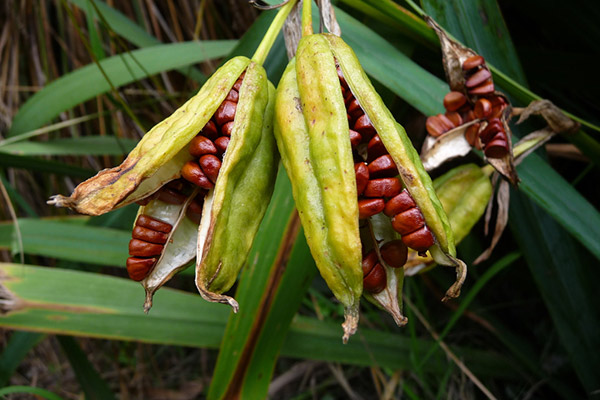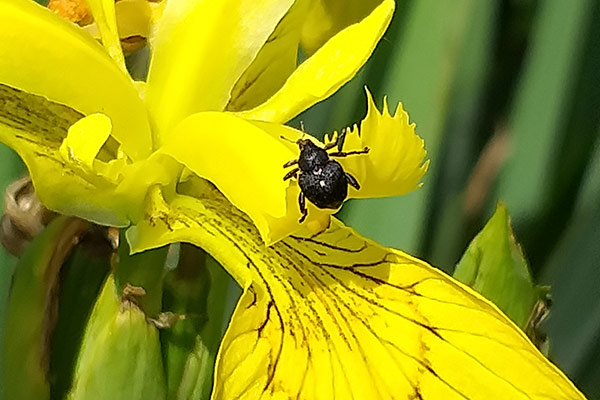Yellow Flag Iris: Beauty Turned Beast
Yellow flag iris (Iris pseudacorus) is a robust, perennial, semi-aquatic iris species with attractive yellow flowers that was once favoured as an ornamental garden plant. However, it is now an unwanted organism under the New Zealand Biosecurity Act 1993, and is listed in the National Plant Pest Accord, prohibiting its sale and distribution.
Yellow flag iris is native throughout Europe, the Mediterranean, western Asia and parts of North Africa, and has been introduced to South and North America, Japan, Korea, South Africa, Australia and New Zealand. It was first recorded as growing wild in New Zealand in 1938 in Lower Hutt and has since spread throughout the country. Christchurch’s Avon River and the Lower Waikato Catchment are the worst affected by populations of yellow flag iris, which have increased rapidly since the mid- to late 2000s. A helicopter survey along the Waikato River in 2011 recorded a 258 ha infestation of yellow flag iris, which has continued to expand, now threatening the internationally significant Whangamarino wetland.
Yellow flag iris grows along the shores of still water bodies such as lakes and ponds, and along slow-flowing rivers and streams. In its introduced range it forms large, dense rhizome mats that crowd out native species, clog waterways and alter hydrological systems through sediment accumulation. Being well adapted to disturbance, it is often associated with human-modified landscapes and structures such as meadows, wet pastures, ditches, the banks of irrigation canals, and constructed wetland trails.
Yellow flag iris is tolerant of a range of environmental conditions, including high salinity, drought, submersion, low pH, and long-term anoxia (absence of oxygen). It can reproduce asexually (vegetatively) from rhizome fragments or sexually from buoyant seeds, and is easily dispersed along waterways, particularly during flooding. This can lead to encroachment onto farmland, where there is a risk of poisoning cattle due to its toxic properties. The poisonous seeds may also affect native birds.

Mechanical and manual control methods are used to manage yellow flag iris infestations but are seldom effective, particularly on a large scale. Chemical control is currently the recommended management method, but this requires repeat applications and is costly. Estimated costs of labour and herbicide are as much as $1,350 per hectare when cover exceeds 40%. However, according to Hamish Hodgson from the Waikato Regional Council, yellow flag iris infestations have become so large in certain parts of the Lower Waikato Catchment that chemical control is not a viable option.
With the growing threat posed by yellow flag iris to New Zealand’s wetlands and river catchments, and the difficulty of controlling large infestations with conventional methods, we recently conducted a feasibility study exploring biocontrol options. According to Chris McGrannachan, who did the feasibility study, biocontrol agents for yellow flag iris have not yet been released anywhere in the world. “However, the Centre for Biological Control (CBC) at Rhodes University in South Africa have initiated a programme and are currently testing candidate insect biocontrol agents,” said Chris. This is potentially of great benefit to New Zealand, since South Africa is doing much of the groundwork, including native range surveys, re-phasing of agents from the northern to the southern hemisphere, and host specificity testing. “This will significantly cut down on the costs associated with developing a biocontrol programme for yellow flag iris in New Zealand and will greatly improve the chances of selecting host-specific and damaging agents, if a programme against this target is to go ahead here,” said Chris.
Collaborators in South Africa are willing to assist and are already conducting research on the genetic diversity of yellow flag iris populations in New Zealand. These will be compared with other invasive populations of yellow flag iris in the southern hemisphere (i.e. South Africa and Argentina) as well as populations in the native range of Europe. This research could pinpoint the origin of the New Zealand populations and should provide useful information for biocontrol programmes worldwide.

Professor Julie Coetzee, Deputy Director of the CBC, said efforts to begin a biocontrol programme against yellow flag iris in South Africa are timely. “I was in Argentina in October last year and the yellow flag iris invasion there was like nothing I have ever seen. This has served as a very loud warning to us in South Africa to get control of this weed as soon as possible,” said Julie. Julie explained that preliminary surveys in the native range identified two potential insect biocontrol agents: the iris flea beetle (Aphthona nonstriata) and the iris seed weevil (Mononychus punctumalbum). Adults of both species feed on the foliage of yellow flag iris, while larvae of the flea beetle mine the leaves, and larvae of the weevil attack the seeds.
The CBC currently have the flea beetle in containment and have started host-specificity tests looking at native species in the genus Dietes, the most closely related genus to the Iris genus in South Africa. According to Julie the results are encouraging. “So far we have had no development of the iris flea beetle on non-target plants, and we are looking at importing the iris seed weevil into containment this coming summer for testing.”

Like South Africa, New Zealand does not have any native Iris species. Several ornamental Iris species of commercial and aesthetic value are cultivated in New Zealand, and these would need to be considered in a biocontrol programme targeting yellow flag iris,” said Chris. “Our closest native relatives are in the genus Libertia (nine of which are endemic), and these would also need to be tested, but are unlikely to be at risk of attack by insects with a narrow host range as they are quite distantly related to yellow flag iris,” explained Chris. After a thorough desk-top study and consultation with the CBC in South Africa, Chris regards the iris seed weevil and the iris flea beetle as the most promising candidate agents for yellow flag iris in New Zealand. Is it time we heed the warnings from South Africa and Argentina that our problems with yellow flag iris might only have just begun?
This project was funded by the Waikato Regional Council.
CONTACT
Chris McGrannachan - mcgrannachanc@landcareresearch.co.nz
